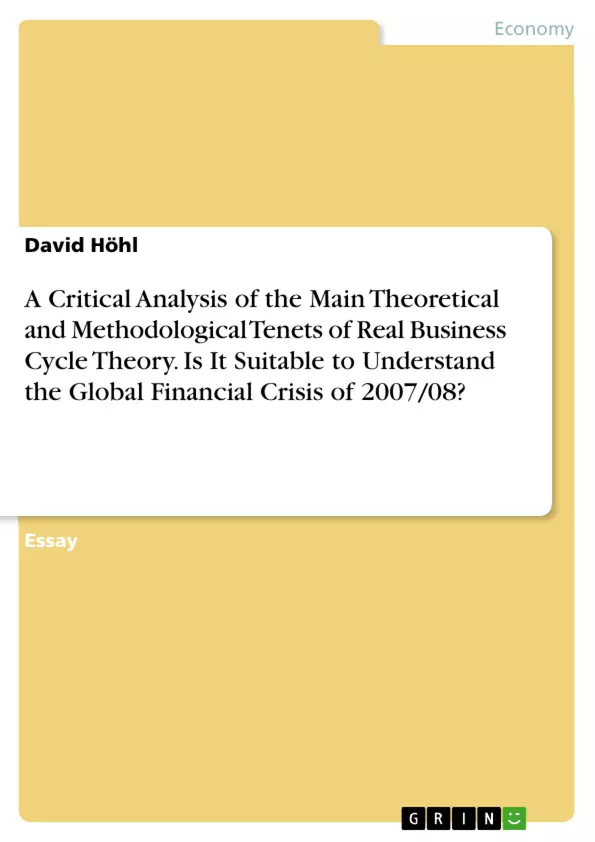“Why did nobody notice it?” asked Queen Elizabeth II. during a visit at London School of Economics (Pierce 2008). She referred to the Global Financial Crisis 2007/08 (GFC). Why did economists fail to advise politicians inasmuch as crises do not arise?
The Real Business Cycle theory (RBCT) was a common framework of analysing economics. Important representatives of RBCT are Edward C. Prescott and Finn E. Kydland. Both won the Nobel prize in economic sciences in 2004 inter alia for their contributions to understand driving forces behind business cycles (BCs) (The Nobel Prize 2018). This essay will analyse how useful RBCT and its policy prescriptions are in understanding and dealing with the GFC.
The thesis statement of this essay is that RBCT and its policy implications are not suitable to understand or deal with the GFC.
First of all, I will give an overview of RBCT. Subsequently, its strengths and weaknesses will be analysed. Then, the GFC will be explained. Afterwards, this essay will contain a comparison between RBCT and Marx’s crisis theory as well as Minsky’s financial instability hypothesis (FIH). Finally, the appropriateness of RBCT and its policy prescriptions to deal with the GFC will be discussed.
Inhaltsverzeichnis (Table of Contents)
- Introduction
- Overview of RBCT
- Analysis of strengths and weaknesses of RBCT
- Explanation of the GFC
- Comparison of RBCT with Marx's crisis theory and Minsky's FIH
- Appropriateness of RBCT to deal with the GFC 2007/08
- Conclusion
Zielsetzung und Themenschwerpunkte (Objectives and Key Themes)
This essay critically analyzes the main theoretical and methodological tenets of Real Business Cycle (RBC) theory. It examines the usefulness of RBC theory and its policy prescriptions in understanding and addressing the Global Financial Crisis of 2007/08. The essay compares RBC theory with earlier attempts to explain business cycles and assesses its suitability to handle the GFC. Key themes explored in the essay include:- The main theoretical and methodological tenets of RBC theory
- The strengths and weaknesses of RBC theory
- The explanation of the Global Financial Crisis of 2007/08
- A comparison between RBC theory and alternative crisis theories
- The appropriateness of RBC theory and its policy prescriptions to deal with the GFC
Zusammenfassung der Kapitel (Chapter Summaries)
- Introduction: This chapter introduces the essay's topic, the Global Financial Crisis of 2007/08, and poses the question of why economists failed to anticipate the crisis. The chapter introduces Real Business Cycle theory (RBCT) as a common framework for economic analysis and states the essay's thesis: RBCT and its policy implications are not suitable to understand or deal with the GFC.
- Overview of RBCT: This chapter provides an overview of the key concepts and assumptions of RBCT, highlighting the contributions of key figures like Edward C. Prescott and Finn E. Kydland.
- Analysis of strengths and weaknesses of RBCT: This chapter analyzes the strengths and weaknesses of RBCT, exploring its theoretical foundations and methodological approaches.
- Explanation of the GFC: This chapter provides an explanation of the Global Financial Crisis of 2007/08, focusing on its key drivers and contributing factors.
- Comparison of RBCT with Marx's crisis theory and Minsky's FIH: This chapter compares RBCT to alternative crisis theories, such as Marx's crisis theory and Minsky's financial instability hypothesis (FIH), highlighting their similarities and differences.
Schlüsselwörter (Keywords)
The essay focuses on the theoretical and methodological foundations of Real Business Cycle (RBC) theory, examining its strengths, weaknesses, and applicability to the Global Financial Crisis (GFC) of 2007/08. It explores key concepts such as business cycles, economic crises, policy prescriptions, and alternative theoretical frameworks like Marx's crisis theory and Minsky's financial instability hypothesis (FIH).- Quote paper
- David Höhl (Author), 2018, A Critical Analysis of the Main Theoretical and Methodological Tenets of Real Business Cycle Theory. Is It Suitable to Understand the Global Financial Crisis of 2007/08?, Munich, GRIN Verlag, https://www.grin.com/document/465437



